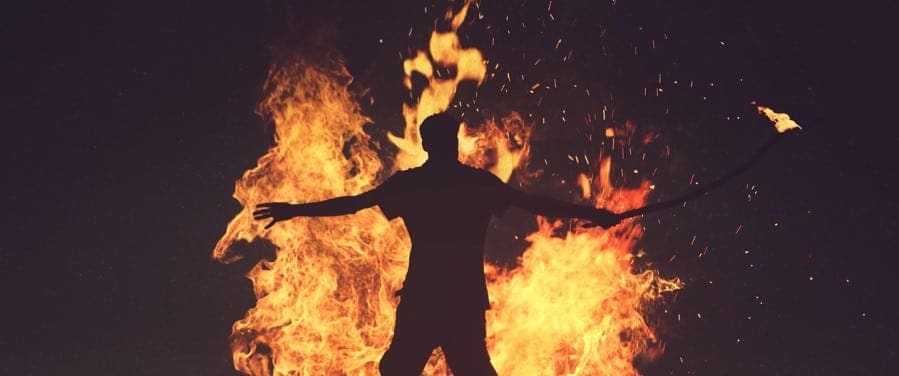When I came to London, I had forgotten that the UK continued to celebrate Guy Fawkes – or as it’s more commonly called, Bonfire Night – until I walked past a store that was prominently advertising the sale of fireworks on Chiswick High Road.
This was my opportunity to reclaim the spirit of the fabled Australian Cracker Night that my uncle had spoken about over the years. Suddenly the stories of ‘ha’penny bungers’ (apparently a common form of firework back in the day) were no longer relegated to myth and legend. They were within my grasp.
So who was Guy Fawkes and why all the fireworks?
Guy Fawkes Day (Bonfire Night) is a British national pastime that, like many things in the United Kingdom, has a twisted and macabre history.
Guy Fawkes was immortalised on the 5th of November, 1605 when he was discovered guarding barrels of gunpowder that had been stashed underneath the House of Lords in London in a Catholic plot to very literally blow up the establishment hierarchy — a protest against the policies of King James I.
Upon the discovery of Fawkes and so the plot’s failure, Londoner’s lit bonfires around the city to celebrate the fact that their King had survived. The 5th of November was subsequently legislated as a national day of thanksgiving called Gunpowder Treason Day.
Over the centuries the commemoration of the Gunpowder Plot’s failure has been a flashpoint for both religious – particularly anti-Catholic – and class orientated conflict. These days it is essentially just a state-sanctioned excuse to let off fireworks and burn things while dancing around like you are at a pagan bacchanal.
From London to Lewes
Organised Bonfire Night fireworks displays are scheduled to take place across London in honour of Guy Fawkes Day.

One of the country’s most prominent events, however, takes place in nearby East Sussex. The Lewes Bonfire Night Celebrations incorporates more than thirty processions marking both the anniversary of the Gunpowder Plot and the related burning of seventeen Catholic martyrs in the town during the 16th Century.
The symbolism of Guy Fawkes is a testament to the manner in which certain events in history can impact on the culture of a nation. For the uninitiated it may seem somewhat stomach-curdling to go to Lewes and see seventeen burning crosses prominently displayed during the ceremony.
What has been used as a symbol of hatred and division in other nations is, in Lewes, quite the opposite: a commemoration of the courage demonstrated by the town’s martyrs during the Reformation. The Lewes Bonfire Night Celebrations is a taste of authentic British culture and provides a unique insight into the psyche of a nation that has had a tumultuous history to say the least.
Remember, remember Cracker Night in Australia?
My uncle grew up in one of Sydney’s outer suburbs during the 1960s, at a time when Australia was in a somewhat awkward ‘teenage phase’. The imperial connection between the United Kingdom and Australia had become more tenuous during the Second World War. Prior to 1966, Australian children bought sweets with pounds and shillings rather than dollars and cents. The Vietnam War was just around the corner, an event that would provoke the anti-authoritarian spirit that would lead to the rise of progressive politics during the 1970s.
Listening to stories from this era makes a young Australian feel like they are looking at a portrait that is only half completed: recognisable, yet uncomfortably different to that image of Australia we have come to expect.
There was always one part of my uncle’s stories that stood out though. Whenever he spoke about ‘Cracker Night’ my ears would perk up, and I would become enraptured by this marvellous and mysterious Australian tradition that seems to have disappeared into obscurity.
Depending on what state you were in, Cracker Night – also sometimes call Bonfire Night – was celebrated on the Queen’s Birthday long weekend in June, 24 May in commemoration of Empire Day (if you go back far enough), or on 5 November to honour the traditional Guy Fawkes Day celebrations that continue to be practiced across Britain every year.
The event though has gradually been erased from modern Australian culture, the wanton explosive mischief of Cracker Night disappearing until all that is left are the wistful memories of a generation.
In a 1965 edition of the Australian Women’s Weekly, journalist Margaret Sydney referred to Cracker Night as “the same old nuisance every year … a nightmare for the fire brigade, a night of horror for many domestic cats and dogs, a worrying time for parents of small children and a blissful and exciting time for those children neither too young nor too old to be dazzled and delighted”.
Perhaps Cracker Night dissolved into obscurity in Australia due to the ‘nuisance’ that Margaret Sydney discussed. That being said, it is hardly a part of the Australian spirit to disavow the exhilaration of Cracker Night due to a bit of inconvenience.
Ultimately the doctors and nurses who had to treat the flood of Cracker Night burns injuries each year had their say and the public sale of those bungers and eventually all fireworks was banned. With the fun taken out of the whole enterprise, Cracker Night became yet another oddity of the past that sadly has no place in modern Australian society.
Experiencing the celebration of Guy Fawkes Day in the United Kingdom, however, provides some hope that the Cracker Night my uncle remembers continues to live on (albeit across the seas and far away). Lighting the fuse on a firework and watching it burst into colour is like reaching back into our past and feeling the same joy that the generations before us did decades ago. Although safety concerns are whittling away at the tradition in Britain each year too.
IMAGES: Via Pixabay












